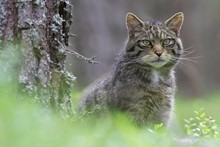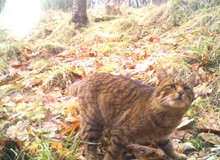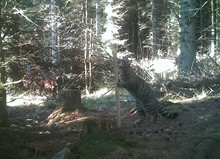16 January, 2018
Crucial work to help save Scottish wildcats
DNA collection and genetic analysis of wild Scottish wildcats is taking place this winter to help guide current and future conservation efforts for this endangered Scottish species.
Scottish Wildcat Action (SWA) and the Royal Zoological Society for Scotland (RZSS) will take part in a short period of wildcat trapping over two months in three of the project’s five priority areas.
The focus of this work is on targeted trapping of wildcats for DNA sampling. All cats trapped and sampled will have full disease screening, pelage scoring and genetic testing.
In addition to the sampling, a number of cats will be fitted with GPS radio tracking collars that will allow researchers to gain a better understanding of how wildcats and feral cats coexist and how this relates to hybridisation.
These procedures will be carried one animal at a time so as to minimise disruption to the animal’s normal routine.
SWA is open and transparent about its work and all studies undertaken will be fully documented and available.
Roo Campbell, the SWA project manager, said: “We are at the stage of the project at which we need firm genetic information on all wildcats left to inform current and future conservation decisions. This information will also give us a clearer view on where population recovery techniques, such as reintroduction, could take place”.
“Trapping will allow us to collect samples for DNA and disease screening. The cat will be released immediately."
Dr Kerry Kilshaw from Oxford University is running further research into wildcats and their behaviour by putting temporary GPS radio tracking collars on wildcats and hybrids to track their movements.
“This information will help us hugely in enabling us to protect them in the future by better understanding their home ranges, den sites and how they use the landscape. It will also allow us to monitor the individuals, using live data of where each wildcat is.”
For further information about the work of Scottish Wildcat Action or to report a wildcat sighting, visit our website www.scottishwildcataction.org or follow us on our social networking sites such as Facebook, Twitter and Instagram.
Wildlife conservation is an important feature of the 2020 Challenge for Scotland’s Biodiversity.
ENDS
Media queries - contact SWA communications coordinator, Duncan McKenzie, at duncan.mckenzie@scottishwildcataction.org, or the SNH press office on 01463 725 022.
Picture use: Please credit Pete Cairns, Scotland: The Big Picture for the Cairngorms wildcat picture, and Scottish Wildcat Action for either of the trail camera pictures.
Contact information
- Name
- SNH Media
- snhmedia@snh.gov.uk
Notes to editors
Scottish Wildcat Action is a partnership project uniting experts from more than 20 key organisations. It is a five-year project working on six wildcat priority areas outlined in the national action plan. It comprises more than 20 key organisations and is supported by Heritage Lottery Funding.
The Scottish Wildcat Action Steering Group comprises Scottish Natural Heritage; Forestry Commission Scotland; Cairngorms National Park Authority; National Museums Scotland; Royal Zoological Society of Scotland; Scottish Gamekeepers Association; Scottish Wildlife Trust; National Trust for Scotland; The Royal (Dick) School of Veterinary Studies - Edinburgh University.
Other organisations who have committed to delivering the Scottish Wildcat Conservation Action Plan: Aigas Field Centre; British Association for Shooting and Conservation; Chester Zoo; Highland Council; Highland Foundation for Wildlife; John Muir Trust; Loch Lomond and Trossachs National Park Authority; National Farmers Union Scotland; Royal Society for the Protection of Birds; Scottish Land and Estates; Wildlife Conservation Research Unit, Oxford University and Aberdeenshire Council.
The Scottish Wildcat (Felis silvestris) is one of our most endangered mammals and our only remaining native cat. It urgently needs action to save shrinking populations in the wild. Following habitat loss and persecution through the 19th century, the wildcat is now restricted in the UK to the Scottish Highlands north of the central belt.
NatureScot is Scotland's nature agency. We work to enhance our natural environment in Scotland and inspire everyone to care more about it. Our priority is a nature-rich future for Scotland and an effective response to the climate emergency. For more information, visit our website at www.nature.scot or follow us on X at https://x.com/NatureScot
’S e NatureScot buidheann nàdair na h-Alba. Bidh sinn a’ neartachadh àrainneachd na h-Alba agus a’ brosnachadh dhaoine gu barrachd suim a chur ann an nàdar. Tha e mar phrìomhachas againn gum bi nàdar na h-Alba beairteach agus gun dèilig sinn gu h-èifeachdach le èiginn na gnàth-shìde. Tha an tuilleadh fiosrachaidh aig www.nature.scot no air X aig https://x.com/NatureScot



